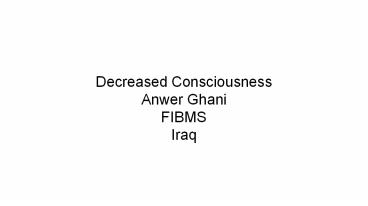decreased consciousness PowerPoint PPT Presentation
Title: decreased consciousness
1
.
Decreased Consciousness Anwer Ghani FIBMS Iraq
2
.
- The major characteristics of consciousness are
alertness and being oriented to place and time.
Alertness means that youre able to respond
appropriately to the people and things around
you. Being oriented to place and time means that
you know who you are, where you are, where you
live, and what time it is.
3
When consciousness is decreased, your ability to
remain awake, aware, and oriented is impaired.
Impaired consciousness can be a medical emergency.
4
Types of decreased consciousness Levels of
impaired consciousness include confusion disorie
ntation delirium lethargy stupor coma
5
Symptoms that may be associated with decreased
consciousness include seizures loss of bowel or
bladder function poor balance falling difficulty
walking fainting lightheadedness irregular
heartbeat rapid pulse low blood
pressure sweating fever weakness in the face,
arms, or legs
6
Confusion Confusion is marked by the absence of
clear thinking and may result in poor
decision-making.
7
Disorientation Disorientation is the inability to
understand how you relate to people, places,
objects, and time. The first stage of
disorientation is usually around awareness of
your current surroundings. The most extreme form
of disorientation is when you lose the memory of
who you are.
8
Delirium If youre delirious, your thoughts are
confused and illogical. People who are delirious
are often disoriented. People who are delirious
are often highly agitated as well.
9
Lethargy Lethargy is a state of decreased
consciousness that resembles drowsiness. If
youre lethargic, you may not respond to
stimulants such as the sound of an alarm clock or
the presence of fire.
10
Stupor Stupor is a deeper level of impaired
consciousness in which its very difficult for
you to respond to any stimuli, except for pain.
11
Coma Coma is the deepest level of impaired
consciousness. If youre in a coma, you cant
respond to any stimulus, not even pain.
12
Common causes of decreased consciousness
include drugs alcohol substance abuse certain
medications epilepsy low blood sugar stroke lack
of oxygen to the brain
13
Other underlying causes of decreased
consciousness include cerebral
hemorrhage dementia, such as Alzheimers
disease head trauma brain tumor heart
disease heat stroke liver disease uremia, or
end-stage kidney failure shock
14
In addition to your complete history and
physical, the doctor may order the following
tests Complete blood count (CBC). This blood
test reveals whether you have a low hemoglobin
level, which indicates anemia. An elevated white
blood cell (WBC) count indicates infections, such
as meningitis or pneumonia. Toxicology screen.
This test uses a blood or urine sample to detect
the presence and levels of medications, illegal
drugs, and poisons in your system. Electrolyte
panel. These blood tests measures levels of
sodium, potassium, chloride, and
bicarbonate. Liver function tests. These tests
determine the health of your liver by measuring
levels of proteins, liver enzymes, or bilirubin
in your blood. Electroencephalogram (EEG). This
exam uses scalp electrodes to evaluate brain
activity. Electrocardiogram (EKG).This exam
measures your hearts electrical activity (such
as heart rate and rhythm). Chest X-ray. Doctors
use this imaging test to evaluate the heart and
lungs. CT scan of the head. A CT scan uses
computers and rotating X-rays to make
high-resolution images of the brain. Doctors use
these images to find abnormalities. MRI of the
head. An MRI uses nuclear magnetic resonance
imaging to make high-resolution images of the
brain.
15
Treating decreased consciousness Treatment for
decreased consciousness depends on whats causing
it.
16
The Glasgow Coma Scale (GCS) is used to
objectively describe the extent of impaired
consciousness in all types of acute medical and
trauma patients. The scale assesses patients
according to three aspects of responsiveness
eye-opening, motor, and verbal responses.
17
The score is the sum of the scores as well as the
individual elements. For example, a score of 10
might be expressed as GCS10 E3V4M3. Best eye
response (4) No eye opening Eye opening to
pain Eye opening to sound Eyes open
spontaneously Best verbal response (5) No verbal
response Incomprehensible sounds Inappropriate
words Confused Orientated Best motor response
(6) No motor response. Abnormal extension to
pain Abnormal flexion to pain Withdrawal from
pain Localizing pain Obeys commands

